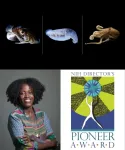(Press-News.org) WILMINGTON, Del. (October 3, 2023) – Many children and adolescent girls diagnosed with an ovarian mass may be able to avoid ovary removal and its lifelong consequences with the use of a consensus-based risk stratification algorithm. Algorithm use helps doctors gauge the patient’s risk of a malignancy and guides preoperative decision making, according to a new multi-institutional study published today in the Journal of the American Medical Association (JAMA).
Researchers at 11 U.S. children’s hospitals found that preoperative use of the algorithm reduced unnecessary ovary removals or oophorectomies from 16.1% of cases before the algorithm was used to 8.4% when it was integrated into practice. The tool--designed by a multidisciplinary team of pediatric surgeons, pediatric and adolescent gynecologists, radiologists, and medical oncologists--very accurately steered low-risk patients to ovary-sparing surgery, misclassifying only 0.7% of those with a malignancy.
“We were very pleased to find that our algorithm significantly reduced unnecessary ovary removal in cases of benign masses and accurately directed these patients to ovary-sparing surgery,” said lead author Peter C. Minneci, MD, MHSc, Chair of the Department of Surgery at Nemours Children’s Health, Delaware Valley. “Oophorectomies can have a number of negative effects on young patients’ health, and this evidence-based tool for preoperative risk stratification and decision-making helps minimize the number oophorectomies performed in the setting of benign masses.”
Oophorectomy can lead to premature ovarian failure, early menopause and increased risks of cognitive impairment, osteopenia, impaired sexual health, and cardiovascular disease. Yet the rates of using ovary-sparing surgery in children whose masses turned out to be benign can range from only 18% up to 77%, depending on the institution and the type of specialist treating a patient – a pediatric surgeon or a pediatric and adolescent gynecologist.
“Adoption of this algorithm could prevent significant lifelong harm caused by unnecessary oophorectomy during adolescence,” the authors concluded.
This study assessed the algorithm’s ability to accurately distinguish between benign and malignant ovarian masses, in hopes of decreasing the number of oophorectomies for benign masses. It included 519 patients aged 6 to 21 undergoing inpatient surgery for an ovarian mass: 96 patients were in a preintervention phase where the algorithm was not used; 105, in an algorithm adoption phase (not included in statistical comparisons); and 318, in the implementation phase using the algorithm.
Researchers in the study – whose institutions are members of the Midwest Pediatric Surgery Consortium – developed the algorithm, which resembles a decision tree. The impetus for this research came from a case of pediatric surgeon Katherine J. Deans, MD, MHSc, the study’s senior author, now Surgeon-in-Chief at Nemours Children’s Health, Delaware Valley. In discussing the patient’s case with a colleague in pediatric and adolescent gynecology, Deans recognized that the specialists were approaching the decision from very different perspectives – prioritizing removal of a potentially malignant mass vs. prioritizing preservation of the patient’s reproductive and long-term health.
“I realized that this important surgical decision depended very much on the perspective of the specialist who saw the patient. What we really needed is reliable evidence-based pre-operative risk stratification to help guide the decision,” said Deans. “This understanding has sparked earlier studies by Consortium members and ultimately the development and implementation of this algorithm, which our study shows removes the variability of care.”
The full algorithm is included in the publication in JAMA with additional information in the accompanying supplement.
The authors plan future studies to build on these findings by further analyzing the data to refine the algorithm. They also plan to study ways to improve fidelity in using it and to conduct implementation studies with additional institutions.
###
About Nemours Children's Health
Nemours Children’s Health is one of the nation’s largest multistate pediatric health systems, which includes two free-standing children's hospitals and a network of more than 70 primary and specialty care practices. Nemours Children's seeks to transform the health of children by adopting a holistic health model that utilizes innovative, safe, and high-quality care, while also caring for the health of the whole child beyond medicine. Nemours Children's also powers the world’s most-visited website for information on the health of children and teens, Nemours KidsHealth.org.
The Nemours Foundation, established through the legacy and philanthropy of Alfred I. duPont, provides pediatric clinical care, research, education, advocacy, and prevention programs to the children, families and communities it serves. For more information, visit Nemours.org.
END
Device can manipulate which organ is driving a disease to study its downstream effects
Can serve as intermediate step between animal studies and clinical trials to test new drugs
‘We wanted to make it as easy as using a smartphone’
Imagine a device smaller than a toddler’s shoebox that can simulate any human disease in multiple organs or test new drugs without ever entering — or harming — the body.
Scientists at Northwestern University have developed this new technology — called Lattice — to study interactions between up to eight unique organ tissue cultures (cells from a human ...
New Discoveries in the Development of Alzheimer's Disease in a Study led by Professor Michael Glickman and Dr. Inbal Maniv from the Faculty of Biology at the Technion were Published in Nature Communications.
Alzheimer's disease was named after the German researcher Dr. Alois Alzheimer, who first described it in 1906. The disease is characterized by the degeneration and death of nerve cells, processes that lead to a progressive impairment of cognitive abilities. It occurs typically in adults over the age of 65, but a small percentage of all Alzheimer's patients are hereditary cases that affect younger ...
The ability to have access to the Internet or use a mobile phone anywhere in the world is taken more and more for granted, but the brightness of Internet and telecommunications satellites that enable global communications networks could pose problems for ground-based astronomy. University of Illinois Urbana-Champaign aerospace engineer Siegfried Eggl coordinated an international study confirming recently deployed satellites are as bright as stars seen by the unaided eye.
“From our observations, we learned that AST Space Mobile’s BlueWalker 3—a constellation prototype satellite featuring a ...
OAK BROOK, Ill. – A new artificial intelligence (AI) model combines imaging information with clinical patient data to improve diagnostic performance on chest X-rays, according to a study published in Radiology, a journal of the Radiological Society of North America (RSNA).
Clinicians consider both imaging and non-imaging data when diagnosing diseases. However, current AI-based approaches are tailored to solve tasks with only one type of data at a time.
Transformer-based neural networks, a relatively new class of AI models, have the ability to combine imaging and ...
A two-phase NIH grant will fund research into a new CRISPR-based gene therapy platform that will target genetic brain diseases like Angelman syndrome and H1-4 (HIST1H1E) syndrome.
A roughly $40 million National Institutes of Health (NIH) grant awarded to Yale School of Medicine will support the development of a gene-editing platform technology capable of reaching the human brain. The innovative new genome-editing technology, which was developed from the first phase from NIH Common Fund Somatic Cell Genome Editing (SCGE) program, could potentially lead to treatments or cures for many neurogenetic diseases.
Neurogenetic disorders ...
When scientists viewed the James Webb Space Telescope’s (JWST) first images of the universe’s earliest galaxies, they were shocked. The young galaxies appeared too bright, too massive and too mature to have formed so soon after the Big Bang. It would be like an infant growing into an adult within just a couple years.
The startling discovery even caused some physicists to question the standard model of cosmology, wondering whether or not it should be upended.
Using new simulations, a Northwestern University-led ...
Van Andel Institute’s Nick Burton, Ph.D., has earned a five-year, nearly $2.9 million New Innovator Award from the National Institutes of Health Common Fund to find new ways to fix or prevent insulin resistance, a key driver of Type 2 diabetes.
Although manageable with treatment, there currently is no way to repair the underlying mechanisms that cause the disease. Furthermore, it remains unclear why some people are more prone to Type 2 diabetes while others are resistant. To find a solution, Burton ...
SAN ANTONIO — October 3, 2023 —A new study led by Southwest Research Institute (SwRI) Planetary Scientist and Associate Vice President Dr. Alan Stern posits that the large, approximately 5-kilometer-long mounds that dominate the appearance of the larger lobe of the pristine Kuiper Belt object Arrokoth are similar enough to suggest a common origin. The SwRI study suggests that these “building blocks” could guide further work on planetesimal formational models. Stern presented these findings this week ...
NEW YORK, Oct. 3, 2023 — Mandë Holford, a professor in the Chemistry and Biochemistry departments at Hunter College and The City University of New York Graduate Center (CUNY Graduate Center), has won a National Institutes of Health Common Fund Pioneer Award for her trailblazing research exploring the therapeutic opportunities and properties of venoms from cephalopods and other marine mollusks. Holford received one of eight Pioneer Awards granted in 2023, which will total more than $47.7 million over five years.
This is the first time a CUNY ...
AUGUSTA, Ga. (Oct. 4, 2022) – A synthetic peptide developed by researchers at the Medical College of Georgia could help reduce vascular problems associated with acute respiratory distress syndrome in COVID-19.
In severe cases, COVID-19 is associated with the syndrome, which happens when fluid builds up in the tiny, elastic air sacs in the lungs, keeping them from filling with enough air and keeping oxygen from reaching the bloodstream. “These are the people who get the sickest from ...







